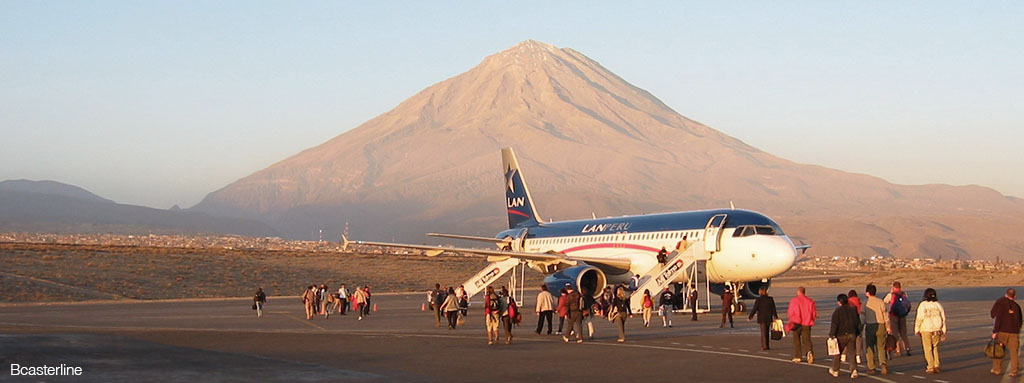Airports are large infrastructures that are usually strategic in nature. One of the basic considerations during the development of airport construction projects, and throughout their whole life cycle, is the existence of risks. The knowledge, management and administration of a risk include its prediction, as well as the implementation of measures aimed at reducing undesirable effects.
Air traffic can sometimes be dependent on phenomena that are not occurring in the air, but rather in the earth.
Risk is an abstract term that is easier to qualify than quantify. We could define it as a danger or threat with an undefined occurrence capacity that can affect human activity. Sometimes it is practically impossible to accurately measure a risk, so we have to limit ourselves to identifying its existence. This is most evident when the risk is also linked to unpredictable phenomena, such as those of natural origin.
With the exception of armed conflicts, natural risks are the most significant among those that can affect an airport. Within these, risks of geological origin are the most important. They can be endogenous phenomena (volcanoes or earthquakes) or exogenous phenomena (hillside movements, floods or collapses), or they can be a combination of the two. In this post we are only going to talk about the endogenous type, which share the features of originating in the interior of the earth and of acting on a scale that greatly exceeds our capacity for containment and prediction.
First of all, it is important to note that, fortunately, projects involving the design, construction and development of airports are already subject to extensive legislation in most countries. They are also managed by professionals who take into account all possible scenarios, and have prevention and control systems in place that help minimise the incidence of these phenomena.
Volcanoes and associated phenomena are possibly the most common geological risks affecting airports across all continents. There are currently almost 2,000 active volcanoes in the world, although most are not permanently active.
In terms of aeronautics, the direct risks inherent in volcanoes are essentially two: the direct effect of an explosive eruption and the effect produced by the emission of ashes. In the first case, we should keep in mind that the eruption column of the crater of any volcano is usually avoided by air routes, so an eruption, however dramatic, does not usually pose a direct risk in itself. The most obvious damage to airports and air traffic is therefore due to the emission of ashes during eruptions. This phenomenon results in the closure of airports and flight bans in the areas affected by the ash cloud due to the danger they pose to turbojet engines.
To cite some examples, recent months have seen the closure of airports in Guatemala (Fuego volcano), Bali (Agung volcano), Java (Merapi volcano), Costa Rica (Turrialba volcano) and Chile (Calbuco volcano). An important case, which had a huge impact on the world economy, was the eruption of the Eyjafjallajökull volcano in Iceland in 2010, which forced the closure of the airspace of 14 European countries and resulted in the cancellation of more than 20,000 flights.
To minimise risks, in the 1990s the ICAO designated nine specialised meteorological centres around the world, giving them the necessary capacity to act as warning centres for the presence of volcanic ash. These centres are responsible for issuing warnings to control centres about the trajectory of ash clouds, as well as about the flight levels that will be affected.
The results obtained from the implementation of this early warning network have been sufficient to avoid impact on flights, minimise incidents and, consequently, improve the safety of air transport.
Another risk of volcanic origin that has occasionally affected airport facilities involves lahars, which are avalanches of water and volcanic products that are highly destructive due to their density and speed. In general, they tend to move along valley bottoms, and can travel more than 50 kilometres from their source. In the case of the Nevado del Ruiz volcano in Colombia, the destruction reached areas that were 80 kilometres away from the origin. In most countries, legislation expressly prohibits the construction of aerodromes in flood zones. This type of phenomenon has therefore rarely caused damage to airports, except in places where the lack of availability of land outweighs other risk variables. In 2008, the Chaitén aerodrome was destroyed by a lahar that came from the slopes of the Chaitén volcano. Another example, also in Chile, is the Pucón aerodrome, which was impacted by the Villarica volcano.
Seismic movements are another endogenous risk that can affect airport infrastructures. Most countries that have seismic zones have developed legislation that describes the exact way in which any infrastructure must be built in order to minimise risks. The big problem with this type of phenomena is the fact that they are practically impossible to predict using current technology.
The consequences of an earthquake in an airport will depend on what part of the infrastructure is affected. In the case of platforms and runways, the most significant effects may be the appearance of cracks, breakage of linear infrastructures (pipes) and the fracture of rigid surfaces, all caused by the differential movements that occur in the terrain. Liquefaction phenomena also occur, the most direct consequence of which is the deterioration of the consistency of the earth and, therefore, the possibility of subsidence and collapse of some structures.
In the case of terminal buildings, the most frequent problems caused by an earthquake are usually centred on non-structural elements (falling panels, ornaments, etc.).
However, even in the areas that are hit hardest by major earthquakes, such as Japan, Chile, Mexico, the United States and all of Central America, earthquakes do not usually have a dramatic impact on airports thanks to appropriate earthquake-resistant construction and measures. With the exception of countries or areas that are very deprived or have very old infrastructures, seismic risk is usually contained.
For this reason, airports are considered good infrastructures for acting as meeting points, providing assistance to victims or organising evacuation.
For example, there have been many large seismic movements that have caused widespread damage in their areas but that have hardly affected airports, essentially simply resulting in the cancellation of flights. This has happened recently in the aerodromes of Mexico (magnitude 7.1 earthquake), Osaka (6.8), Caracas (7.3) and Lombok-Indonesia (6.3). However, there are exceptions, such as the recent earthquake in Indonesia, which (temporarily) disabled the airport of Palu, and even resulted in the collapse of the control tower.
Airports are designed, built and operated looking at the sky, but we must not lose sight of the fact that some of the most important factors to consider may be under the ground.



